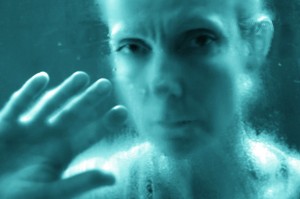Lynette Wallworth’s media artworks offer us a tactile experience of digital aesthetics. Her latest piece, Unheard Voices: Invisible by Night, is an outdoor, interactive video installed at the Melbourne VIsitor Centre, Federation Square. Commissioned by Experimenta, Invisible By Night uncovers the secret history of Melbourne’s most public building.

Images: courtesy Experimenta
The work is subtly fused with the controversial architecture of this contemporary memorial, revealing layered histories of site to create a deep, emotional reaction.
From within the building, projected onto an exterior window of the centre, the ghostly form of a woman appears as though trapped inside. She emerges silently at dusk, approaching and receding from the glass.
A layer of mist covers the interior of the window, disguising the woman’s features. Her chillingly present form is imbued with its own life force – illuminated video glowing with the etherial vibrancy of ghosts.
Wallworth describes the woman’s movements as “achingly slow and repetitive, like grief itself… enacting the worn gestures of someone who is in pain and from whom the pain cannot be removed – the tiredness of grief.
The contextualisation of a grieving woman in a public space evokes the strength of our compassion, overriding our prevalent disconnection between urban and communal life. Early in the evening her presence is barely noticed as busy pedestrians rush past. But late at night, when the city stills, lone strangers linger with a hand against the window, reaching out to this mysterious woman.
The viewer perceives this act of compassion temporarily suspend the women’s cycle of grieving. Wiping the glass clean, she creates a lasting moment of clarified vision, revealing the detail of her sadness and loss. In this instant there is “a small break in our atmospheric differences” as past and present unite.
Wallworth found it appropriate to link this site to a sense of grieving. During her investigations she discovered that this area was a traditional meeting place for the Boonerwrung people. Colonisation, however, displaced the traditional inhabitants. Between 1891 and 1888 teh site bacame home to the Princes Bridge Morgue. The morgue was built to accommodate the sudden influx of immigrants throughout the Gold Rush.

Images: courtesy Experimenta
The woman, suspended in a vertical cryogenics tomb, connotes the personal histories of the people of the land, of those interred at the morgue, and of the people currently experiencing the site; our collective stories forever woven in the architectures which house us. This reincarnation, or re-enactment of history suggests the concept of “layered histories of site… the sense that a site contains emanations of these complex layers, both pre and post colonisation.”
Wallworth sees the work commenting on aspects of our national identity which allow us to live amongst unacknowledged histories of site. In this regard it ws significant that the work be installed at Federation Square – one of the few architectural developments to have accommodated the history of a location. Federation Square’s community-focused design hs returned the ara to its former role as meeting place for celebration and protest.
Invisible By Night signals our neglect of ‘histories of site’ through our more immediate lack of compassion for those that suffer amongst us. Its attention to the transient beauty of compassion and interaction traversed boundaries of urban community and history.
Production
Lynette Wallworth holds a New Media Arts Fellowship from the Australia Council for the Arts and is currently working on installation projects in Iran, Massachusetts and New Mexico. Her works focus primarily on the interplay between moving image, sound, space and audience.
Invisible By Night was assisted by Roberto J Salvatore – DOP, editor, Ivanka Sokol – performer, Marden Dean and Erin White – lighting, Ian Corcoran – production manager and Daniel Horwood – interface designer.
Daniel Horwood’s design of the interactive componenet of the work used an infrared emitter and receiver to detect the placing of a hand on the glass. The IR emitter was pulsed at 38kHz through the glass. When a hand was placed on the (other side of the) glass, the 38kHz infrared signal would reflect back through the glass. These reflections were detected by an IR receiver (placed directly underneath the emitter). He used a PIC16F84 micro controller to receive from the sensor and MIDI to interface the sensors with the G4. He designed the interactive video playback software using Pd http://www-crca.ucsd.edu/~msp/software.html with the GEM video library http://gem.iem.at .
Due to problems with the site and building, temporary solutions wree developed for every element. The work was not able to permanently alter any aspect of teh building. They also had to design a failsafe system that could be bumped in and out every night. All sensors had to be internal to the site, responding through two thick layers of glass coated with UV and infrared filters. Horwood was eventually able to bypass the filters by carefully angling the sensor. After installation he implemented software filters to deal with false triggering caused by incidental street sources and electrical noise.
Unheard Voices: Invisible By Night was visible from sunset to sunrise at the Melbourne Visitors Centre, Federation Square. Unheard Voices: Invisible By Night was produced as an Experimenta Commission, presented in association with the Melbourne International Arts Festival, October 5 – 23, 2004. More information is available at http://www.experimenta.org
Rebecca Cannon
Rebecca Cannon is a new media artist, curator and producer in Melbourne. Her award-winning videos and animations have screened at major festivals worldwide.
 This work is licensed under a Creative Commons Attribution-NonCommercial-ShareAlike 2.5 Australia.
This work is licensed under a Creative Commons Attribution-NonCommercial-ShareAlike 2.5 Australia.






